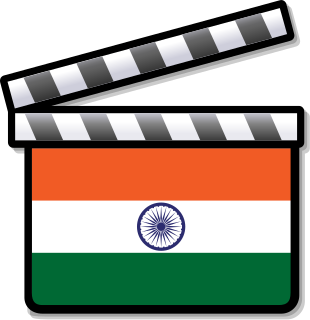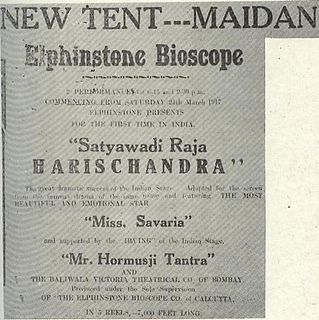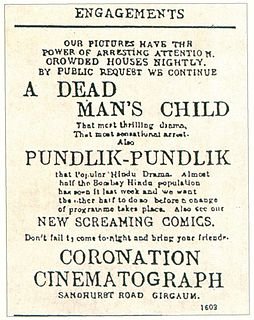Related Research Articles

The Dadasaheb Phalke Award is India's highest award in the field of cinema. It is presented annually at the National Film Awards ceremony by the Directorate of Film Festivals, an organisation set up by the Ministry of Information and Broadcasting. The recipient is honoured for their "outstanding contribution to the growth and development of Indian cinema" and is selected by a committee consisting of eminent personalities from the Indian film industry. The award comprises a Swarna Kamal medallion, a shawl, and a cash prize of ₹1,000,000 (US$13,000).

Dhundiraj Govind Phalke, popularly known as Dadasaheb Phalke, was an Indian producer-director-screenwriter, known as "the Father of Indian cinema". His debut film, Raja Harishchandra, was the first Indian movie released in 1913, and is now known as India's first full-length feature film. He made 95 feature-length films and 27 short films in his career, spanning 19 years, until 1937, including his most noted works: Mohini Bhasmasur (1913), Satyavan Savitri (1914), Lanka Dahan (1917), Shri Krishna Janma (1918) and Kaliya Mardan (1919).

Raja Harishchandra is a 1913 Indian silent film directed and produced by Dadasaheb Phalke. It is often considered the first full-length Indian feature film. Raja Harishchandra features Dattatraya Damodar Dabke, Anna Salunke, Bhalchandra Phalke, and Gajanan Vasudev Sane and is based on the legend of Harishchandra, with Dabke portraying the title character. The film, being silent, had English, Marathi, and Hindi-language intertitles.

Marathi cinema is an Indian film industry of Marathi-language motion pictures. It is based in Mumbai, Maharashtra. Based in old Mumbai, it is the oldest film industry of Indian cinema. The first Marathi film to be released in India was Shree Pundalik by Dadasaheb Torne on 18 May 1912 at Coronation Cinematograph, Mumbai. and a Marathi crew who were performing Marathi and Sanskrit Sangeet natikas (musicals) and plays in Marathi at that period.
Coronation Cinematograph and Variety Hall was a hall in the Girgaon area of south Mumbai, India used for variety entertainment shows, dramas and to screen movies.

Satyawadi Raja Harishchandra is a 1917 silent black and white Indian film based on Hindu mythology, directed by Rustomji Dhotiwala. It was produced by J. F. Madan's Elphinstone Bioscope. Credited as the first remake in Indian cinema, the film is a remake of the first Indian feature film, Raja Harishchandra (1913) and was also inspired by an Urdu language drama, Harishchandra. The film is based on the mythological story of a Hindu King Harishchandra, the 36th king of the Solar Dynasty, who donated his entire kingdom and sold himself and his family to keep the promise given to the sage Vishvamitra in the dream. It is also the first feature film made in Calcutta. The intertitles used in the film were in Bengali language as the film was a silent film. The film was released on 24 March 1917 at New Tent Maidan, Calcutta.

Harishchandrachi Factory is a 2009 Indian Marathi-language biographical film written and directed by Paresh Mokashi. It is about Dadasaheb Phalke, who made the first Indian feature film Raja Harishchandra (1913), and starring Nandu Madhav as him and Vibhavari Deshpande as his wife Saraswati. Harishchandrachi Factory focuses on the struggle Phalke faced during its production.
The Indian Animation Industry encompasses traditional 2D animation, 3D animation and visual effects for feature films. In 1956, Disney Studios animator Clair Weeks, who had worked on Bambi, was invited to Films Division of India in Mumbai to establish and train the country's first animation studio as part of the American technical co-operation mission. He trained a core group of Indian animators, whose first production was a film called The Banyan Deer (1957). Veteran animator Ram Mohan started his career at Films Division's Cartoon Unit.
Harishchandra is an Indian king mentioned in ancient Hindu religious texts.
The 1st National Film Awards, presented by Ministry of Information and Broadcasting, India to felicitate the best of Indian Cinema censored in the year 1953. Ceremony took place at Vigyan Bhavan, New Delhi on 10 October 1954 and awards were given by then President of India, Dr Rajendra Prasad.

The 59th National Film Awards, presented by the Directorate of Film Festivals, honoured the best of Indian cinema for 2011 and took place on 3 May 2012 at Vigyan Bhavan, New Delhi. Awards were presented in 38 categories in the Feature Films section, 20 categories in the Non-Feature Films section and two categories for the Best Writing on Cinema section; 41 jury members chose the winners from 392 entries. The ceremony was hosted by actors Vinay Pathak and Saumya Tandon. Awards were presented by the Vice-President of India, Mohammad Hamid Ansari. The ceremony was broadcast live on three television channels, eleven All India Radio stations, and webcast live.

Paresh Mokashi is an Indian filmmaker, producer, actor and Theatre director-producer; working predominantly in Marathi cinema and Marathi theatre. He started working as a backstage worker for theatre and did few minor roles for plays as well as films. Mokashi made his directorial debut for theatre with the Marathi play, Sangeet Debuchya Mulee in 1999. He continued to work for theatre and made his directorial debut for cinema with the 2009 Marathi feature film, Harishchandrachi Factory. The film depicts the making of India's first full-length feature film, Raja Harishchandra (1913), made by Dadasaheb Phalke. The film was acclaimed critically and won several awards. It was also selected as India's official entry to 82nd Academy Awards in the Best Foreign Language Film category.

Shree Pundalik, which was released on 18 May 1912 at the Coronation Cinematograph, Girgaum, Mumbai, is sometimes considered the first feature-length Indian film by a minority. The government of India and most scholarly sources consider Raja Harishchandra to be the first Indian feature film, and detractors argue Pundalik was only a photographic recording of a popular play. It was produced and directed by Dadasaheb Torne.
Durgabai Kamat was a Marathi actress, who was the first actress in Indian cinema. She was born in brahmin family In the early 1900s, acting in film or theatre was a taboo for women, so much so Dadasaheb Phalke, the father of Indian cinema, had to use male actors for female roles in first Indian film, Raja Harishchandra. However with its success, female actresses were encouraged. Thus he introduced Kamat in his 1913 second movie Mohini Bhasmasur as a leading lady Parvati, while her daughter Kamlabai Gokhale, played the role of Mohini, thus becoming the first female child actress of Indian cinema. After Kamat, other actresses started working in cinema.
Satyavadi Raja Harishchandra is a 1917 silent black and white Indian short film directed and produced by Dhundiraj Govind Phalke. The film is a shorter version of the first Indian feature film, Raja Harishchandra (1913), also directed and produced by Phalke. The intertitles used in the film were in Marathi language as the film was a silent film. The film is based on the mythological story of a Hindu King Harishchandra, the 36th king of the Solar Dynasty, who donated his entire kingdom and sold himself and his family to keep the promise given to the sage Vishvamitra in the dream.

Lanka Dahan is a 1917 Indian silent film directed by Dadasaheb Phalke. Phalke also wrote the film based on an episode of the Hindu epic Ramayana, credited to Valmiki. The film was Phalke's second feature film after the 1913 Raja Harishchandra, which was the first Indian full-length feature film. Phalke also directed various short films in between.
Mohini Bhasmasur is a 1913 Indian mythological film directed by Dhundiraj Govind Phalke and starring Kamlabai Gokhale and Durgabai Kamat. It is India's and Phalke's second full-length feature film. Mohini Bhasmasur is the first Indian film to have a female actor. In Raja Harischandra, India's and Phalke's first film, the role of the female was played by Anna Salunke, a male.

Anna Hari Salunke, also known as A. Salunke and Annasaheb Saluke, was an Indian actor who performed female roles in very early Indian cinema and also a cinematographer. He is credited as the first person to perform as a heroine in Indian cinema when he played the role of Rani Taramati of King Harishchandra in Dada Saheb Phalke's first full-length film, Raja Harishchandra (1913). In 1917, Salunke became the first to play a double role in Indian cinema, by playing the roles of both the hero and heroine in Lanka Dahan.
The history of animation in India can be traced to the early 20th century. Precursors to modern animation such as shadow puppets and slide shows entertained audiences before the advent of the cinema. Pioneers such as Dadasaheb Phalke, Gunamoy Banerjee, K.S. Gupte and G.K. Ghokle kept the tradition of animation alive during the first half of the 20th century. Such individuals were usually self-taught and were inspired by foreign cartoons.
References
- ↑ filmhistory, Indian (16 July 2021). "D D Dabke". IndianFilmHistory. Retrieved 16 July 2021.
- ↑ Watve, Bapu (2012) [2004]. Dadasaheb Phalke, The Father of Indian Cinema. Translated by Virkar, S. A. National Book Trust. p. 38. ISBN 978-81-237-4319-6.
- ↑ Sen, Shomini (19 February 2013). "100 years of Indian cinema: How Bombay became Bollywood". CNN-news18. Retrieved 7 July 2018.